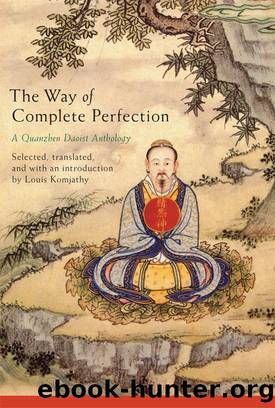Way of Complete Perfection, The: A Quanzhen Daoist Anthology by Komjathy Louis;

Author:Komjathy, Louis; [Komjathy]
Language: eng
Format: epub
Tags: Religion, Taoism, Eastern, philosophy, Taoist
ISBN: 9781438446530
Google: U1rA_P5cq2cC
Publisher: SUNY Press
Published: 2013-06-05T23:57:15.178272+00:00
Chapter Six
Hagiographical Ideals
Hagiographies, or âaccounts of saints,â are religious texts aimed at documenting the lives of major personages and at inspiring other adherents or potential members of the tradition. The genre is perhaps most often associated with the lives of medieval Catholic saints.1 Hagiographies frequently include tales of extraordinary qualities, uncommon feats, and miraculous occurrences. In this way, hagiography differs from a modern notion of âbiography,â or third-person accounts of an individual that aim at âaccuracyâ and âobjectivity.â At the same time, hagiography is not âfiction.â The study and reading of hagiography requires that one reflect on the compiler's potential motivations and concerns, those of his or her religious community, the intended audience, as well as audience expectations and generic conventions (see Campany 2002, 98â100). Moreover, as Robert Campany has pointed out,
To hagiography as a type of writing we can apply the tired but serviceable notion that it, like other religious representations, serves as both âmodel ofâ and âmodel forâ; that is to say, it is both descriptive of and prescriptive for religious life. The hagiographies of any religious tradition are where its airy speculations, its abstract pronouncements, and its systematic prescriptions for life touch ground in particularity and assume the scale of the human. Precisely because hagiography intends to inspire belief, veneration, and perhaps emulation, its depictions of the contexts of religious life must be, for the most part, realistic, which is to say, recognizable and familiar to readers. We too easily forget to ponder the expectations of the readers for whom premodern hagiographies were written, whose mental and social landscape was part of what was portrayed in them. Because it announces itself as an account of the lives of real persons, hagiography must meet readers on that familiar landscape before attempting to move them to the horizon where it meets transcendence; it must give a recognizable model for life as readers know it, and cannot content itself only with giving models for the ideal religious life. (2002, 100â1)
Download
This site does not store any files on its server. We only index and link to content provided by other sites. Please contact the content providers to delete copyright contents if any and email us, we'll remove relevant links or contents immediately.
| Africa | Americas |
| Arctic & Antarctica | Asia |
| Australia & Oceania | Europe |
| Middle East | Russia |
| United States | World |
| Ancient Civilizations | Military |
| Historical Study & Educational Resources |
Machine Learning at Scale with H2O by Gregory Keys | David Whiting(4192)
Never by Ken Follett(3799)
Fairy Tale by Stephen King(3221)
The Man Who Died Twice by Richard Osman(2998)
Oathbringer (The Stormlight Archive, Book 3) by Brandon Sanderson(2898)
Will by Will Smith(2795)
Rationality by Steven Pinker(2291)
The Dark Hours by Michael Connelly(2246)
Can't Hurt Me: Master Your Mind and Defy the Odds - Clean Edition by David Goggins(2229)
The Dawn of Everything: A New History of Humanity by David Graeber & David Wengrow(2123)
Friends, Lovers, and the Big Terrible Thing by Matthew Perry(2123)
Principles for Dealing With the Changing World Order: Why Nations Succeed and Fail by Ray Dalio(1974)
HBR's 10 Must Reads 2022 by Harvard Business Review(1778)
A Short History of War by Jeremy Black(1763)
Go Tell the Bees That I Am Gone by Diana Gabaldon(1689)
515945210 by Unknown(1602)
A Game of Thrones (The Illustrated Edition) by George R. R. Martin(1594)
Kingdom of Ash by Maas Sarah J(1529)
443319537 by Unknown(1471)
